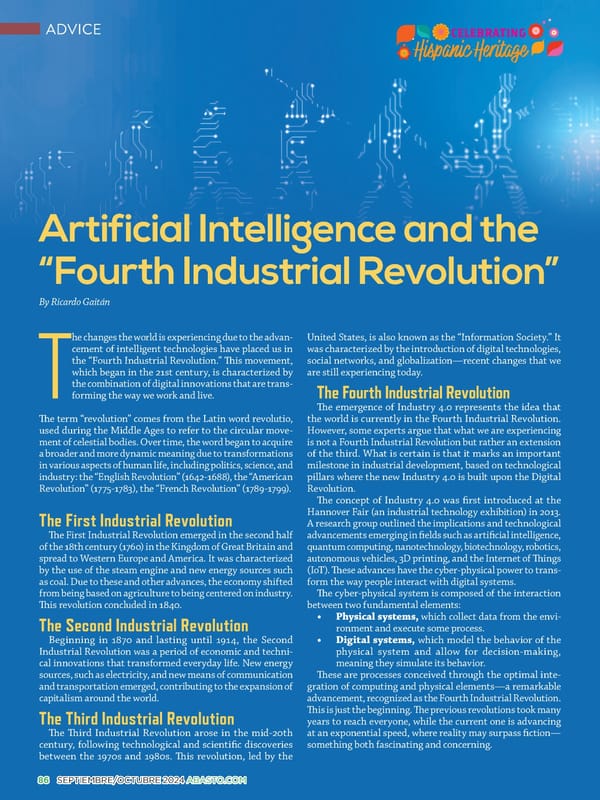La Cuarta Revolución Industrial, Abasto Magazine
ADVICE CELEBRATING Hispanic Heritage Artificial Intelligence and the “Fourth Industrial Revolution” By Ricardo Gaitán he changes the world is experiencing due to the advan- United States, is also known as the “Information Society.” It cement of intelligent technologies have placed us in was characterized by the introduction of digital technologies, the “Fourth Industrial Revolution.” 吀栀is movement, social networks, and globalization—recent changes that we which began in the 21st century, is characterized by are still experiencing today. the combination of digital innovations that are trans- Tforming the way we work and live. The Fourth Industrial Revolution 吀栀e emergence of Industry 4.0 represents the idea that 吀栀e term “revolution” comes from the Latin word revolutio, the world is currently in the Fourth Industrial Revolution. used during the Middle Ages to refer to the circular move- However, some experts argue that what we are experiencing ment of celestial bodies. Over time, the word began to acquire is not a Fourth Industrial Revolution but rather an extension a broader and more dynamic meaning due to transformations of the third. What is certain is that it marks an important in various aspects of human life, including politics, science, and milestone in industrial development, based on technological industry: the “English Revolution” (1642-1688), the “American pillars where the new Industry 4.0 is built upon the Digital Revolution” (1775-1783), the “French Revolution” (1789-1799). Revolution. 吀栀e concept of Industry 4.0 was 昀椀rst introduced at the Hannover Fair (an industrial technology exhibition) in 2013. The First Industrial Revolution A research group outlined the implications and technological 吀栀e First Industrial Revolution emerged in the second half advancements emerging in 昀椀elds such as arti昀椀cial intelligence, of the 18th century (1760) in the Kingdom of Great Britain and quantum computing, nanotechnology, biotechnology, robotics, spread to Western Europe and America. It was characterized autonomous vehicles, 3D printing, and the Internet of 吀栀ings by the use of the steam engine and new energy sources such (IoT). 吀栀ese advances have the cyber-physical power to trans- as coal. Due to these and other advances, the economy shifted form the way people interact with digital systems. from being based on agriculture to being centered on industry. 吀栀e cyber-physical system is composed of the interaction 吀栀is revolution concluded in 1840. between two fundamental elements: • Physical systems, which collect data from the envi- The Second Industrial Revolution ronment and execute some process. Beginning in 1870 and lasting until 1914, the Second • Digital systems, which model the behavior of the Industrial Revolution was a period of economic and techni- physical system and allow for decision-making, cal innovations that transformed everyday life. New energy meaning they simulate its behavior. sources, such as electricity, and new means of communication 吀栀ese are processes conceived through the optimal inte- and transportation emerged, contributing to the expansion of gration of computing and physical elements—a remarkable capitalism around the world. advancement, recognized as the Fourth Industrial Revolution. 吀栀is is just the beginning. 吀栀e previous revolutions took many The Third Industrial Revolution years to reach everyone, while the current one is advancing 吀栀e 吀栀ird Industrial Revolution arose in the mid-20th at an exponential speed, where reality may surpass 昀椀ction— century, following technological and scienti昀椀c discoveries something both fascinating and concerning. between the 1970s and 1980s. 吀栀is revolution, led by the 8686 SSEEPPTTIIEEMBRMBREE//OOCCTTUUBRBREE 2 2002244 AABBAASSTOTO..CCOOMM
 Abasto Magazine: September/October 2024 - ENGLISH Page 109 Page 111
Abasto Magazine: September/October 2024 - ENGLISH Page 109 Page 111